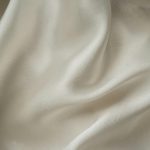Want to master the art of identifying 100% cotton fabric? You're not alone. Imagine confidently picking up any piece of clothing and knowing, without a doubt, whether it's pure cotton.
In 'Is It 100% Cotton? 5 Easy Ways to Tell,' you'll learn five foolproof methods to determine the fiber content of any fabric. These techniques will empower you to make informed choices and avoid synthetic imposters.
From visual inspection and fabric feel to the burn test and label check, you'll soon be equipped with the knowledge to discern the true nature of any fabric.
Get ready to unravel the mystery and become an expert in identifying 100% cotton with ease.
Key Takeaways
- Visual inspection and label check: Examine the fabric closely for shiny or unnatural-looking fibers and check for labels or tags that provide information about the fiber content. Look for phrases like '100% cotton' or 'All cotton' in the fabric composition section.
- Burn test: Observe the flame color, smoke, and residue when burning a small piece of fabric. Pure cotton typically burns with a steady, bright flame and smells like burning paper or leaves. Cotton usually produces minimal smoke when burned and leaves behind fine, feathery ash with a soft texture.
- Fabric feel: Assess fabric composition by feeling for cotton's characteristic softness. Cotton is highly absorbent and feels breathable, with a slightly grainy texture due to the plant-based fibers. Softness, absorbency, and graininess are key indicators of cotton's presence in the fabric.
- Label check: Always check the label to verify if the fabric is 100% cotton. Look for phrases like '100% cotton' or 'All cotton' in the fabric composition section. Pay attention to care instructions for washing and ironing recommendations. Labels provide valuable insights into fabric quality and characteristics.
Visual Inspection
To determine if a fabric is 100% cotton, you can visually inspect the material for any synthetic fibers or blends. Start by examining the fabric closely, looking for any shiny or unnatural-looking fibers that could indicate the presence of synthetic materials. Pure cotton tends to have a matte finish and a soft, slightly fuzzy texture.
Additionally, check the fabric for any labels or tags that provide information about the fiber content or material composition. These labels are legally required to accurately reflect the fabric's composition. If the label states that the fabric is 100% cotton, it's likely to be so. However, keep in mind that some blends may still contain a high percentage of cotton, so it's essential to read the label carefully.
Furthermore, you can perform a burn test by carefully burning a small piece of the fabric to observe the ash and smell, but this requires caution and should be done by a professional if you're unsure.
Burn Test
You can perform a burn test on the fabric to determine if it's 100% cotton. This simple yet effective method can provide valuable insights into the fabric composition and material durability.
Here's what you need to know:
- Observation: When you burn a small piece of the fabric, take note of the flame color, smoke, and the residue left behind. These observations can indicate whether the fabric is cotton or a blend.
- Flame Color: Pure cotton typically burns with a steady, bright flame and smells like burning paper or leaves.
- Smoke: Cotton usually produces minimal smoke when burned, and the smoke smells like burning paper.
- Residue: After burning, cotton leaves behind fine, feathery ash with a soft texture.
Conducting a burn test can help you confidently determine if the fabric is 100% cotton based on its burning characteristics. This method is a handy tool for anyone seeking to identify fabric composition and assess material durability.
Fabric Feel
Assess fabric composition by feeling the texture for cotton's characteristic softness and natural ability to absorb moisture. When evaluating fabric texture, consider the following key points to help determine if the material is 100% cotton:
| Fabric Texture | Characteristics |
|---|---|
| Softness | Cotton has a naturally soft feel, often described as smooth and comfortable against the skin. |
| Absorbency | Cotton is highly absorbent, capable of holding up to 27 times its weight in water. It feels breathable and can absorb sweat and moisture, making it ideal for warm weather clothing. |
| Graininess | Cotton fabric may have a slightly grainy texture due to the plant-based fibers, giving it a unique tactile quality. |
When examining fabric texture, pay attention to these characteristics to identify the presence of cotton in the material. The softness, absorbency, and graininess are key indicators of cotton's presence in the fabric composition. By familiarizing yourself with these fabric textures, you can confidently distinguish genuine cotton from other materials, ensuring that you are getting the quality and comfort you desire.
Label Check
When shopping for fabric, always check the label to verify if it's 100% cotton. The label contains crucial information about the fabric composition and care instructions. Here's what to look for on the label:
- Fabric composition: The label will specify the materials used to make the fabric. Look for the phrase '100% cotton' or 'All cotton' to ensure that the fabric is purely cotton and not a blend with other fibers.
- Care instructions: The label also provides essential care instructions such as washing and ironing recommendations. Following these instructions will help maintain the fabric's quality and appearance.
- Additional information: Some labels may include details about the fabric's origin, thread count, or special treatments. This information can offer valuable insights into the fabric's quality and characteristics.
Bleach Test
To determine the fabric's composition, perform a bleach test on a small, inconspicuous area. This test helps in identifying whether the fabric is 100% cotton or contains synthetic fibers.
First, mix one-part bleach with five parts water. Then, apply a small amount of this solution to an inconspicuous area of the fabric. Wait for a few minutes and observe any color changes.
If the fabric contains cotton, it will likely start to whiten or fade due to the bleach's effect on natural fibers. However, if there's no change in color, the fabric may not be 100% cotton.
This test also helps in assessing the fabric's colorfastness and strength. If the color bleeds or fades significantly, it indicates poor colorfastness, meaning the fabric is likely to lose color when washed or exposed to sunlight. Additionally, if the fabric weakens or disintegrates upon contact with the bleach solution, it suggests low fabric strength, which can impact its durability.
Keep in mind that while the bleach test can provide valuable insights, it should be conducted cautiously to prevent damage to the fabric.
Frequently Asked Questions
How Do I Determine if a Fabric Is 100% Cotton Without Using Any Tests or Inspections?
To determine if a fabric is 100% cotton without using tests or inspections, start with a visual inspection. Look for a natural, slightly uneven texture. Then, do the feel test by touching the fabric to gauge its softness and breathability.
Are There Any Common Fabric Blends That May Be Mistaken for 100% Cotton Using These Methods?
When identifying fabric alternatives, be aware of common blends that can be mistaken for 100% cotton. Some misleading materials include polyester-cotton blends or rayon. Identifying imitations requires attention to texture, appearance, and burn test results.
Can I Use These Methods to Determine the Quality of the Cotton Fabric?
You can use these methods to assess fabric quality and determine the authenticity of the cotton. By examining the fabric's texture, burn test, and label information, you can confidently evaluate the quality of the cotton.
Are There Any Environmental or Ethical Considerations When Determining if a Fabric Is 100% Cotton?
When determining if a fabric is 100% cotton, it's crucial to consider environmental impact and ethical sourcing. Look for certifications like organic or fair trade, and research the brand's sustainability practices to make informed decisions.
Can These Methods Be Used to Distinguish Between Different Types of Cotton, Such as Organic or Egyptian Cotton?
To distinguish between organic and Egyptian cotton, follow these methods for identifying different cotton types. Consider ethical sourcing and environmental impact to ensure you're making an informed choice. These methods can help you make a mindful decision.
- The Ultimate Comparison: Woven vs. Nonwoven Fabric Properties - July 11, 2025
- Nonwoven Polypropylene Safety: A Full Breakdown - July 11, 2025
- Care Instructions for Nonwoven Fabrics: Washing and Drying - July 11, 2025







